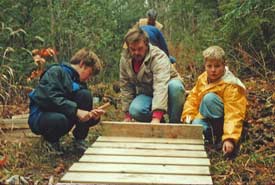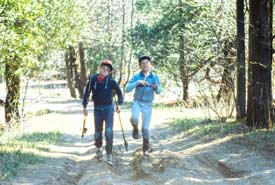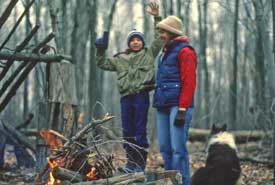Why our pedestrian trails are more important than ever

Trail building with the cubs (Photo by Bill Wilson)
I believe that pedestrian hiking trails are more important for the welfare of our communities than ever before. I’d like to elaborate on why this is so. I’d also like to express why it so very important for more volunteers to support our local hiking trail clubs across the country.
Pedestrian pathways in the woods have been important and memorable to me for most of my lifetime. When I started building trails such as the Humber Valley Trail, I made several discoveries. I rediscovered the childhood sensation of quiet contemplative enjoyment and discovery outdoors. I also got exercise outdoors in the company of like-minded trail building people.
More members of my community of Bolton began to use our local trail because it became a unique opportunity to socialize together.
Later I was pleased to see how much even more members of my community began to use the trail to enjoy the wonders of a natural river valley.
Soon we understood that walking and hiking on our trails was powerful preventative medicine, having clear health benefits at no cost.
Still later, we saw trails as key supports of the environmental movement given that our trails were largely in natural landscapes and could thereby directly help people, particularly children, appreciate the diversity of nature.
All these important reasons remain as clear benefits of our walking and hiking trails as priceless assets in our communities.

Mark and Steve at Newfane woodlot (Photo by Bill Wilson)
More recently, an even more significant realization of the importance of our pedestrian trails has dawned on us. We are now in an era of rapid urbanization combined with fewer opportunities for outdoor education for youth. The estrangement of children from nature is a worrisome phenomenon which Terri LeRoux, past president of Hike Ontario, recently brought to the Ontario public’s attention with her eye-opening presentation at the 2009 Hike Ontario Summit in Trenton. It was entitled Nature Deficit Disorder and brought us up to date with the latest research into how children are losing contact with nature.
Nature Deficit Disorder was first publicized in Richard Louv’s 2005 book Last Child in the Woods. This book has attracted world-wide attention and appeals for increased childhood nature education.
The main reasons cited for the estrangement of children from nature are:
- increasing electronic entertainment/communications,
- controlled play atmosphere in our urban communities,
- less than 10 percent of Canadian households having the luxury of access to a cottage or second home in a natural setting, and
- decreased access to nature education programs for youth.

Mark, Sandy and Ebony at Newfane woodlot (Photo by Bill Wilson)
These discoveries prompt me to ask the questions: Without access to our pedestrian trails, how and where else can children even begin to know what a healthy environment looks like? How will they begin to appreciate our natural environment? And then how will they ever learn to protect it, or even vote for its protection?
I do not dwell on the fear that this question implies. Many nature deficit causes are out of our control. It does prompt me to simply state that all volunteer members of local hiking and trail clubs have been, for many years, an essential part of a positive response to nature deficit.
Many pedestrian trails continue to offer direct contact with nature for all walks of life including our children. Local trails continue to offer a safe experience with nature free of charge.
Indeed our pedestrian trails and the expertise of our hiking clubs are more important to society than ever as cradles of our awareness of nature as well as individual self discovery, connecting Canadians to nature in meaningful ways.
I urge you all to continue your trail efforts and stewardship. I invite many more volunteers to join your excellent and valuable work.


